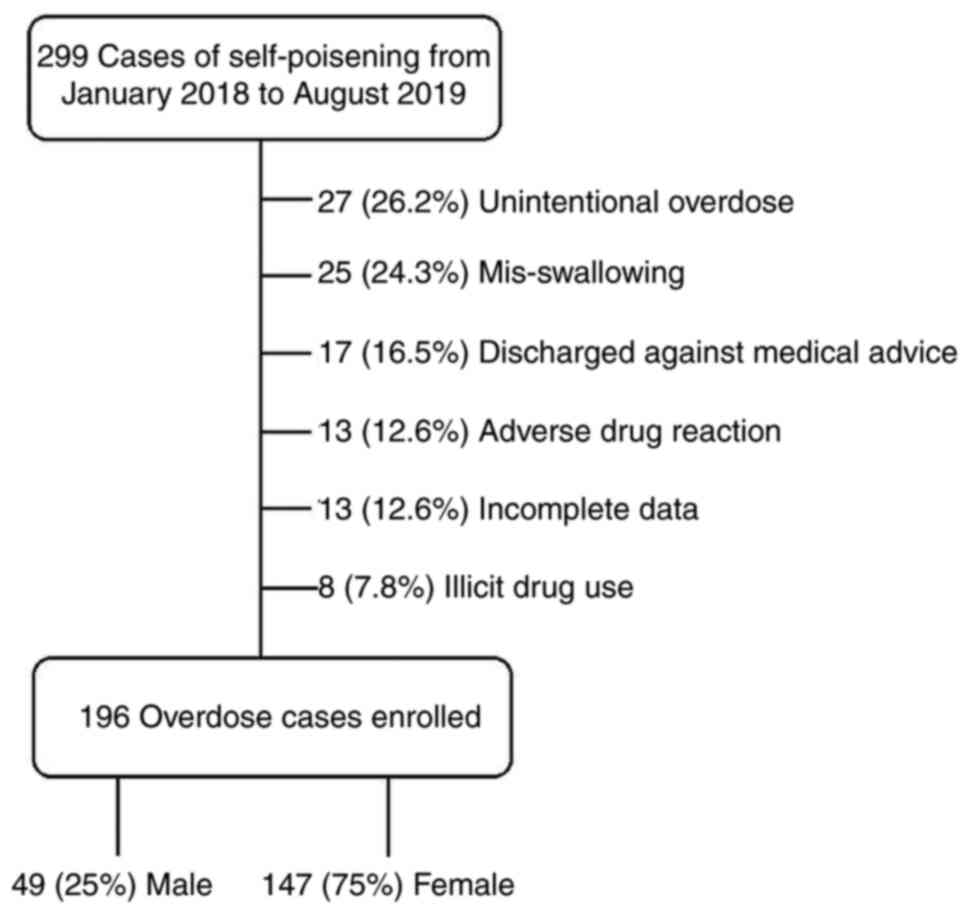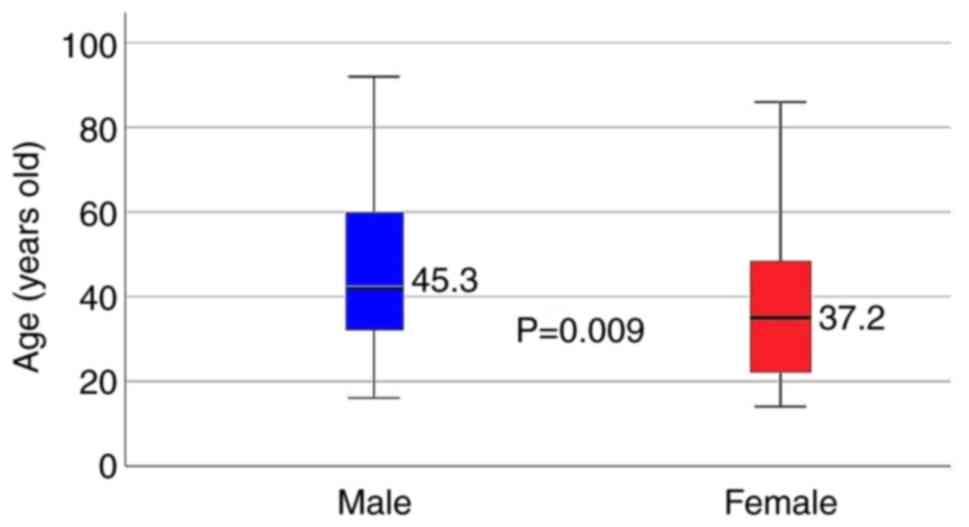|
1
|
Hedegaard H, Miniño AM and Warner M: Drug
Overdose Deaths in the United States, 1999-2018. NCHS Data Brief.
National Center for Health Statistics, Hyattsville, MD, 2020.
|
|
2
|
Yang CC, Wu JF, Ong HC, Hung SC, Kuo YP,
Sa CH, Chen SS and Deng JF: Taiwan National Poison Center:
Epidemiologic data 1985-1993. J Toxicol Clin Toxicol. 34:651–663.
1996.PubMed/NCBI View Article : Google Scholar
|
|
3
|
Chien WC, Lin JD, Lai CH, Chung CH and
Hung YC: Trends in poisoning hospitalization and mortality in
Taiwan, 1999-2008: a retrospective analysis. BMC Public Health.
11(703)2011.PubMed/NCBI View Article : Google Scholar
|
|
4
|
Darke S, Williamson A, Ross J, Mills KL,
Havard A and Teesson M: Patterns of nonfatal heroin overdose over a
3-year period: Findings from the Australian treatment outcome
study. J Urban Health. 84:283–291. 2007.PubMed/NCBI View Article : Google Scholar
|
|
5
|
Schweitzer VG, Darrat I, Stach BA and Gray
E: Sudden bilateral sensorineural hearing loss following
polysubstance narcotic overdose. J Am Acad Audiol. 22:208–214.
2011.PubMed/NCBI View Article : Google Scholar
|
|
6
|
Pattanaik S, Dhamija P, Malhotra S, Sharma
N and Pandhi P: Evaluation of cost of treatment of drug-related
events in a tertiary care public sector hospital in Northern India:
A prospective study. Br J Clin Pharmacol. 67:363–369.
2009.PubMed/NCBI View Article : Google Scholar
|
|
7
|
Qin P, Agerbo E, Westergård-Nielsen N,
Eriksson T and Mortensen PB: Gender differences in risk factors for
suicide in Denmark. Br J Psychiatry. 177:546–550. 2000.PubMed/NCBI View Article : Google Scholar
|
|
8
|
Tóth MD, Ádám S, Birkás E, Székely A,
Stauder A and Purebl G: Gender differences in deliberate
self-poisoning in Hungary: Analyzing the effect of precipitating
factors and their relation to depression. Crisis. 35:145–153.
2014.PubMed/NCBI View Article : Google Scholar
|
|
9
|
International Statistical Classification
of Diseases and Related Health Problems, 10th revision, 5th
edition. Vol 2, 2010. WHO Library Cataloguing-in-Publication Data,
2010.
|
|
10
|
Jee HJ, Cho CH, Lee YJ, Choi N, An H and
Lee HJ: Solar radiation increases suicide rate after adjusting for
other climate factors in South Korea. Acta Psychiatr Scand.
135:219–227. 2017.PubMed/NCBI View Article : Google Scholar
|
|
11
|
Hakko H, Räsänen P and Tiihonen J:
Seasonal variation in suicide occurrence in Finland. Acta Psychiatr
Scand. 98:92–97. 1998.PubMed/NCBI View Article : Google Scholar
|
|
12
|
Amiri B, Pourreza A, Rahimi Foroushani A,
Hosseini SM and Poorolajal J: Suicide and associated risk factors
in Hamadan province, west of Iran, in 2008 and 2009. J Res Health
Sci. 12:88–92. 2012.PubMed/NCBI
|
|
13
|
Rocchi MB, Sisti D, Cascio MT and Preti A:
Seasonality and suicide in Italy: Amplitude is positively related
to suicide rates. J Affect Disord. 100:129–136. 2007.PubMed/NCBI View Article : Google Scholar
|
|
14
|
Vougiouklakis T, Boumba VA, Mitselou A,
Peschos D and Gerontopoulos K: Trends in suicide mortality in the
deprived region of Epirus (north-west Greece) during the period
1998-2002. Med Sci Law. 45:39–46. 2005.PubMed/NCBI View Article : Google Scholar
|
|
15
|
Preti A, Miotto P and De Coppi M: Season
and suicide: Recent findings from Italy. Crisis. 21:59–70.
2000.PubMed/NCBI View Article : Google Scholar
|
|
16
|
Mann JJ: The serotonergic system in mood
disorders and suicidal behaviour. Philos Trans R Soc Lond B Biol
Sci. 368(20120537)2013.PubMed/NCBI View Article : Google Scholar
|
|
17
|
Miller JM, Hesselgrave N, Ogden RT,
Sullivan GM, Oquendo MA, Mann JJ and Parsey RV: Positron emission
tomography quantification of serotonin transporter in suicide
attempters with major depressive disorder. Biol Psychiatry.
74:287–295. 2013.PubMed/NCBI View Article : Google Scholar
|
|
18
|
Sund-Levander M, Forsberg C and Wahren LK:
Normal oral, rectal, tympanic and axillary body temperature in
adult men and women: A systematic literature review. Scand J Caring
Sci. 16:122–128. 2002.PubMed/NCBI View Article : Google Scholar
|
|
19
|
Mackowiak PA: Temperature regulation and
pathogenesis of fever. In: Douglas and Bennett's Principles and
Practice of Infectious Diseases. Mandell GL, Bennett's JE and Dolin
R (eds). 6th edition. Elsevier-Churchill Livingstone, pp703-717,
2005.
|
|
20
|
Wiinberg N, Høegholm A, Christensen HR,
Bang LE, Mikkelsen KL, Nielsen PE, Svendsen TL, Kampmann JP, Madsen
NH and Bentzon MW: 24-h Ambulatory blood pressure in 352 normal
Danish subjects, related to age and gender. Am J Hypertens.
8:978–986. 1995.PubMed/NCBI View Article : Google Scholar
|
|
21
|
Veisani Y, Delpisheh A, Sayehmiri K,
Moradi G and Hassanzadeh J: Seasonality in violent and nonviolent
methods of suicide attempts: A CrossSectional study on systematic
registry data. Acta Med Iran. 55:507–513. 2017.PubMed/NCBI
|
|
22
|
Bando DH, Brunoni AR, Fernandes TG,
Benseñor IM and Lotufo PA: Suicide rates and trends in São Paulo,
Brazil, according to gender, age, and demographic aspects: A
joinpoint regression analysis. Braz J Psychiatry. 34:286–293.
2012.PubMed/NCBI View Article : Google Scholar
|
|
23
|
Jessen G, Andersen K, Arensman E,
Bille-Brahe U, Crepet P, De Leo D, Hawton K, Haring C, Hjelmeland
H, Michel K, et al: Temporal fluctuations and seasonality in
attempted suicide in Europe. Arch Suicide Res. 5:57–69. 1999.
|
|
24
|
Chung KH, Lee HC, Kao S and Lin HC:
Urbanicity and methods of suicide: A nationwide population-based
study. J Urban Health. 85:136–145. 2008.PubMed/NCBI View Article : Google Scholar
|
|
25
|
Corcoran P and Nagar A: Suicide and
marital status in Northern Ireland. Soc Psychiatry Psychiatr
Epidemiol. 45:795–800. 2010.PubMed/NCBI View Article : Google Scholar
|
|
26
|
Ide N, Wyder M, Kõlves K and De Leo D:
Separation as an important risk factor for suicide: A systematic
review. J Fam Issues. 31:1689–1716. 2010.
|
|
27
|
Kposowa AJ: Divorce and suicide risk. J
Epidemiol Commun Health. 57(993)2003.
|
|
28
|
Kweon YS, Hwang S, Yeon B, Choi KH, Oh Y,
Lee HK, Lee CT and Lee KU: Characteristics of drug overdose in
young suicide attempters. Clin Psychopharmacol Neurosci.
10:180–184. 2012.PubMed/NCBI View Article : Google Scholar
|
|
29
|
Clapperton A, Newstead S, Bugeja L and
Pirkis J: Relative risk of suicide following exposure to recent
stressors, Victoria, Australia. Aust N Z J Public Health.
43:254–260. 2019.PubMed/NCBI View Article : Google Scholar
|
|
30
|
Murphy GE: Why women are less likely than
men to commit suicide. Compr Psychiatry. 39:165–175.
1998.PubMed/NCBI View Article : Google Scholar
|
|
31
|
Cohen D: ‘The American National
Conversation about (Everything but) Shame.’. Soc Res. 70:1073–1108.
2003.
|
|
32
|
Thoits PA: ‘Self, identity, and mental
health’. In: Handbook of the Sociology of Mental Health. Aneshenel
CS, Phelan JC and Avinson WR (eds). Springer, New York, NY,
pp357-377, 2013.
|
|
33
|
Pollack WS: The ‘war’ for boys: Hearing
‘real boys’ voices, healing their pain. Professional Psychology.
37:190–195. 2006.
|
|
34
|
Borges G, Orozco R and Medina Mora ME:
Risk index for attempted suicide in Mexico. Salud Publica Mex.
54:595–606. 2012.PubMed/NCBI View Article : Google Scholar : (In Spanish).
|
|
35
|
Rasmussen ML, Hjelmeland H and Dieserud G:
Barriers toward help-seeking among young men prior to suicide.
Death Stud. 42:96–103. 2018.PubMed/NCBI View Article : Google Scholar
|
















